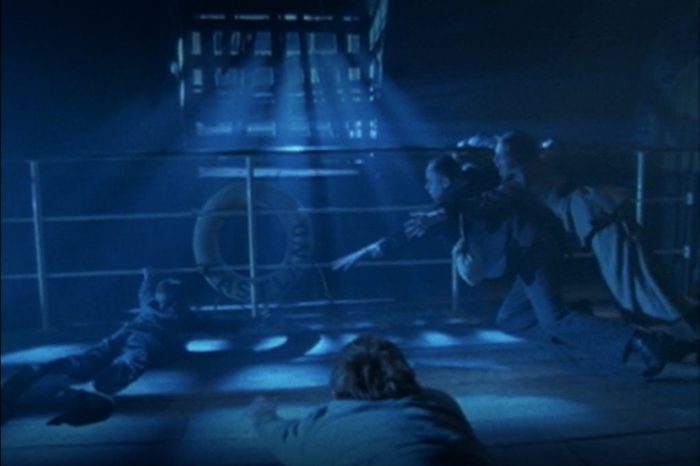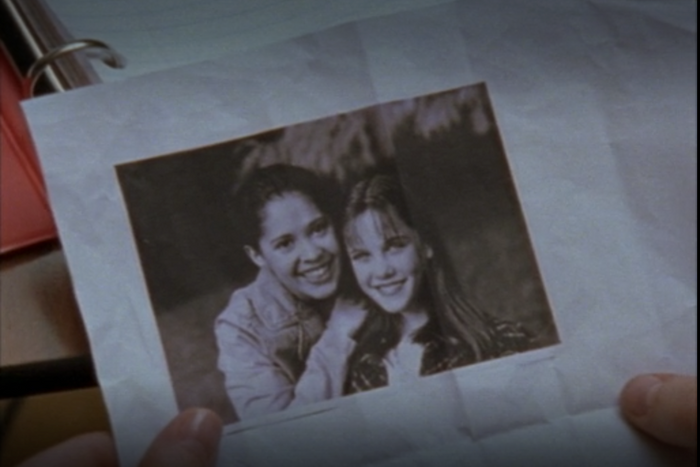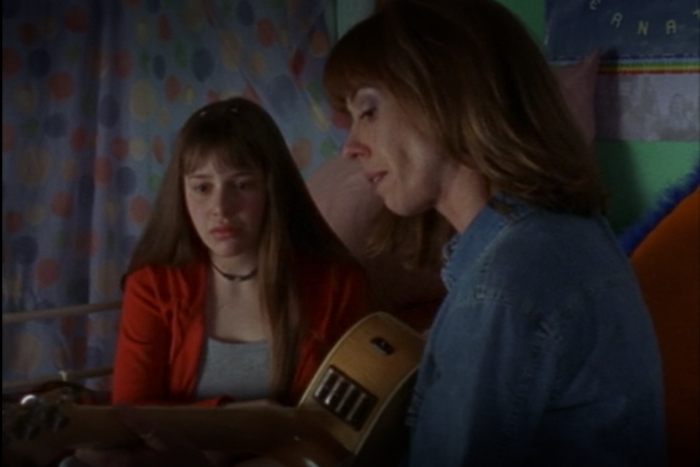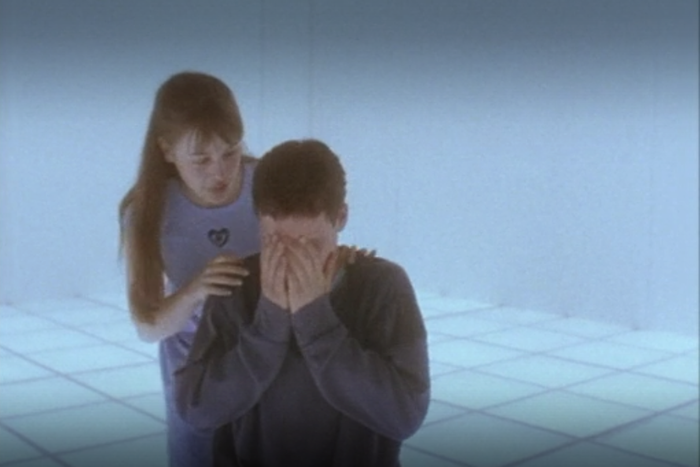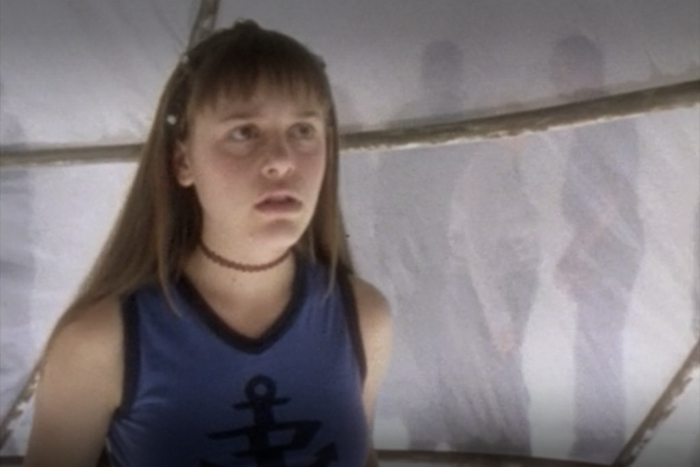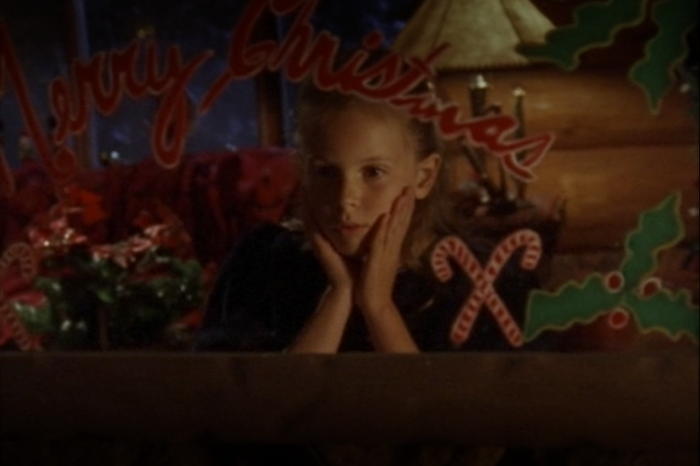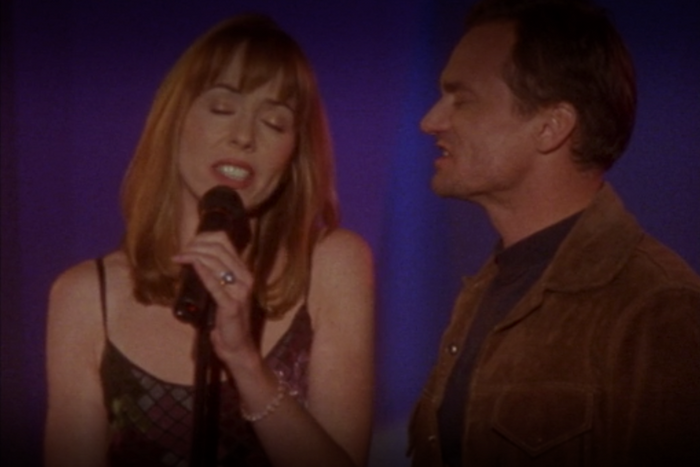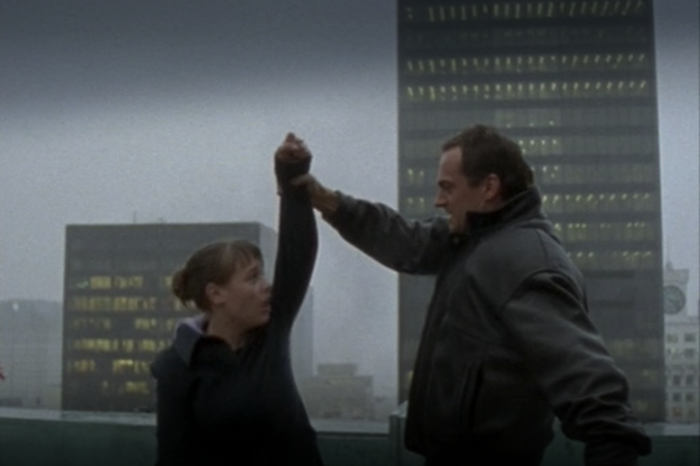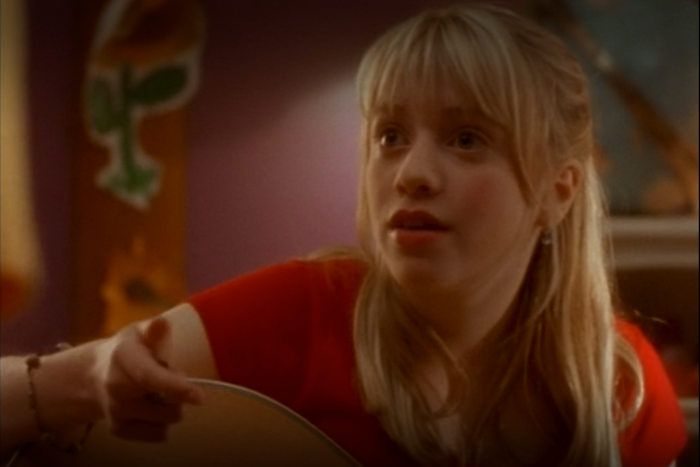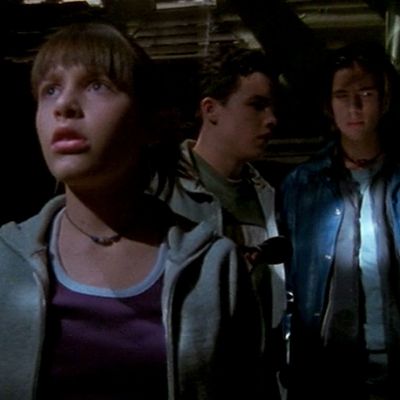
Often cited as the starter show for many horror fans today, Disney ChannelÔÇÖs So Weird ÔÇö┬ánow available to stream on Disney+ ÔÇö follows Fiona ÔÇ£FiÔÇØ Phillips (Cara DeLizia), an internet-obsessed teen who investigates the paranormal. Every episode starts the same: Fi gives a bit of history about what spooky, supernatural story she and her brother Jack (Patrick Levis) will encounter. She then reveals the next stop on her rock-star mom Molly PhillipsÔÇÖs (Mackenzie Phillips) first solo tour following the death of her husband and bandmate Rick (Chris Gibson), who died when Fi was 3 years old. From aliens to astral projection, each episode and tour stop highlights a new paranormal phenomenon, usually digging deeper into how Fi and her family continue to process RickÔÇÖs death and try to avoid grief along the way.
Similar to its more grown-up counterparts like The X-Files and Buffy the Vampire Slayer, what started out as an escape for ghost-hunting, UFO-loving children became something more human. So Weird captured the universal struggle of what it meant to be a tween growing up on the cusp of the new millennium. But what stands out the most upon rewatching So Weird now is how much it has in common with family dramas like Six Feet Under, showing a familyÔÇÖs dedication to keeping their patriarchÔÇÖs memory and lifeÔÇÖs work alive.
The theme of home┬áÔÇö┬áand So WeirdÔÇÖs at times almost nightmarish version of home ÔÇö┬ádrives many of the plots throughout the series. Fi sometimes sees her lack of memory of her father as a way to not fully connect with her home and family, while being on the road can serve as a way for Molly and Jack to escape from the broken memories of Rick that haunt them. But those themes would ultimately prove too dark for Disney ChannelÔÇÖs squeaky-clean image, and the show was completely reworked to be more bright and upbeat, and not all that weird in its third and final season.
Despite DisneyÔÇÖs misgivings, the first two seasons of So Weird are well worth revisiting, especially if you were a weird ÔÇÖ90s kid who loved all things spooky and strange ÔÇö or if you missed this early Disney Channel era and want to see what it was like before the Lizzie McGuires and Hannah Montanas took over. But if youÔÇÖre not sure you want to sit through every monster of the week, the list below highlights the ten best episodes of So Weird you can watch to get a sense of the showÔÇÖs whole deal.
ItÔÇÖs worth noting that IÔÇÖve mostly included episodes that feature strong ties to the main overarching plot and highlight what So Weird does best ÔÇö using the paranormal and early-2000s internet tropes to help Fi process her fatherÔÇÖs loss and grow closer with her family. But if you are craving a good dose of camp, here are some honorable mentions: Whether your paranormal tastes lean more toward astral projection (ÔÇ£EscapeÔÇØ), goblins (ÔÇ£SimplicityÔÇØ), UFOs (ÔÇ£MemoryÔÇØ and ÔÇ£ListenÔÇØ), or a pre-Black Mirror-esque story of a teenage boy uploading his soul to the internet (ÔÇ£AvatarÔÇØ), thereÔÇÖs a So Weird episode for you.
With that, hop on the tour bus and turn on your laptops, things are about to get so weird.
ÔÇ£Family ReunionÔÇØ (Season 1, Episode 1)
The series premiere opens with Fi checking emails for her paranormal website, FiÔÇÖs So Weird Webpage. After clicking on someoneÔÇÖs ÔÇ£real home video of a UFO sighting!ÔÇØ (donÔÇÖt you know never to click mysterious email links, Fi?!), it turns out to be a prank by her brother, a flash animation of his head flying out of hers. Oh, early-aughts internet. The room shakes, revealing that this isnÔÇÖt your ordinary teenage bedroom ÔÇö┬áitÔÇÖs a tour bus. And thus begins So WeirdÔÇÖs paranormal time capsule of the early internet.
The tour bus first stops in Chicago, where Fi instantly senses the presence of the ghost of a young boy. After investigating deep-web archives (this is pre-Google, you know), she connects the boyÔÇÖs death to the 1915 sinking of the SS Eastland in the Chicago River. With nods to the Titanic, the episodeÔÇÖs climax shows Fi transported back in time to the site of the boyÔÇÖs death, as she watches his family fail to save him from tragically drowning in the waters below. ItÔÇÖs a heavy start to a childrenÔÇÖs series, to say the least. But it sets up the showÔÇÖs core of family first, and introduces FiÔÇÖs desire to explore the supernatural experiences that follow her on tour and later connect her to her father.
ÔÇ£RebeccaÔÇØ (Season 1, Episode 9)
Fi asks at the start of this episode, ÔÇ£If you could live forever, would you?ÔÇØ A timeless question explored throughout mythology ÔÇö but what if you didnÔÇÖt have a choice? Fi learns the answer to this question when she meets MollyÔÇÖs childhood best friend Rebecca, years after her family moved across the country, devastating a then-13-year-old Molly. Only problem? SheÔÇÖs still 13. Rebecca isnÔÇÖt exactly eternal though ÔÇö it just takes her 100 years to grow one year older, making her 1,327. In order to keep others from knowing RebeccaÔÇÖs secret, she and her family must flee every few years to start a new life. This heartbreaking episode captures how hard it is to lose a childhood best friend and how that genuine connection can impact you for life.
ÔÇ£MediumÔÇØ (Season 2, Episode 1)
Season two begins with Fi and her family returning to their hometown of Fort Collins, Colorado, bringing the Phillipses back to their roots and setting up for a new season that dives even deeper into a familyÔÇÖs love and the lengths theyÔÇÖll go for one another. But there are ghosts living among them and Fi, Jack, and Molly have to learn to accept and confront these memories, whether theyÔÇÖre emotionally ready or not.
After a celebrity medium is exposed by an undercover reporter as a fraud, Fi is devastated  but her longing for connection with her father isnt too off course. In fact, the reporter who exposed the phony medium is actually the real deal himself (thats how hes so good at exposing fakes), and he eventually tries to help Fi. The episode ends on a poignant note: Fi magically plays one of her fathers songs that she supposedly learned through his spirit. Molly recognizes the chords and confronts Fi, sparking an argument about their conflicting responses to Ricks memory. Its every day, its everywhere, Molly tells Fi. Especially in this house  its terrible to hate the memories, but they keep me stuck. I cant move forward, and I blame him because he wont leave me alone.
ÔÇ£NightmareÔÇØ (Season 2, Episode 4)
ÔÇ£Why do we dream of people and places weÔÇÖve never seen before? Why do some people have the same dream?ÔÇØ Fi and the gang explore the concept of convergent dreams after they all end up in the same nightmare world thatÔÇÖs terrorizing Danny, the son of a family friend. Or so they think.
After the nightmare returns Jack to his last memory of his father on the night he died, and later his fatherÔÇÖs funeral, Jack confronts those heavy feelings. But itÔÇÖs not his grief thatÔÇÖs burdening him ÔÇö itÔÇÖs his fear of losing Fi and his mom the same way. In fact, ÔÇ£the monsterÔÇÖs always been after him.ÔÇØ Danny has a fear thatÔÇÖs weighing him down as well; the monster in his dream is a projection of his parents unknowingly scaring their son and DannyÔÇÖs resulting fear of losing them. ItÔÇÖs is a touching-yet-harrowing commentary on how parentsÔÇÖ actions can affect their children, for better or worse.
ÔÇ£BansheeÔÇØ (Season 2, Episode 11)
Fi reconnects with her Irish heritage when her family stops at her grandparentsÔÇÖ home. Not long after their arrival, Fi hears screaming coming from her grandparentsÔÇÖ bedroom and sees a ghostlike creature floating above her grandfatherÔÇÖs body. ItÔÇÖs later revealed that their family has a history of banshees following their namesake, which usually appear right before death. Devastated, Fi sets off after the banshee and asks the creature to reconsider her grandfatherÔÇÖs fate. She agrees, but not before Fi angrily asks why the banshee took her father so soon. Turns out, it wasnÔÇÖt fate at all ÔÇö some other, more evil powers were at work.
ÔÇ£Strange GeometryÔÇØ (Season 2, Episode 12)
There are many moments throughout So Weird where MollyÔÇÖs friends and other family members criticize her decision to tell Fi more about her father and what he was investigating in the final years of his life, but in ÔÇ£Strange GeometryÔÇØ we finally get the answers Fi deserves. After Fi discovers a late architect trapped behind a DIY portal to the spirit world, the man presents Fi with a seemingly impossible task: to reset the portalÔÇÖs membrane so he can return to his body and soul once more. Fi almost gives in when he reveals he can also return FiÔÇÖs fatherÔÇÖs spirit, but instead, she destroys the spirit portal at the last minute ÔÇö taking the architectÔÇÖs spirit and her chance of reconnecting with her father with it.
But thereÔÇÖs a connection thatÔÇÖs been there all along ÔÇö her love for the paranormal. Molly finally tells Fi about her fatherÔÇÖs obsession, and how she believes it led to his ultimately death. Fi is of course devastated ÔÇö all this time she thought she was weird and different when the paranormal was actually pretty normal (for the Phillips family anyway).
ÔÇ£FountainÔÇØ (Season 2, Episode 13)
After a family tradition is halted due to a last-minute charity-show performance, Fi turns to the past to rediscover what the holidays truly mean in this spin on A Christmas Carol. She discovers a mysterious ÔÇÖ50s-style soda counter in an empty part of a mall food cart, and one sip of a festive soda sends Fi back backward in time to revisit younger versions of herself on Christmas Eve pasts. Each year, sheÔÇÖs able to get new insights on how the holiday affected her family before and after the loss of her father.
ÔÇ£EncoreÔÇØ (Season 2, Episode 24)
ItÔÇÖs rare that a clip show┬áÔÇö┬áan episode essentially filled with scenes from past episodes ÔÇö┬áis in any way memorable, let alone drives any plotlines forward. Replacing FiÔÇÖs usually supernatural backstory, this episode begins with Molly reminiscing about the first time she saw Rick onstage and her memories of performing with him. Before Molly starts her set, FiÔÇÖs still buzzing about her newly discovered connection with her father and is convinced ÔÇ£weÔÇÖre being guided by something.ÔÇØ
But when Molly decides to quit her tour for good, fearing that the supernatural encounters are endangering them (and possibly MollyÔÇÖs fear that FiÔÇÖs obsessions will lead her to the same fate as her father), sheÔÇÖs sent into a nostalgic spiral, remembering everything thatÔÇÖs happened on tour, while playing her career-spanning set list that drives the episode and highlights MollyÔÇÖs grief and struggle to control Fi. It all comes together when, for the first time, Molly returns to the stage to sing one of RickÔÇÖs songs, ÔÇ£Another World.ÔÇØ His ghost joins her for one final, haunting encore performance before ending her tour.
ÔÇ£TwinÔÇØ (Season 2, Episode 26)
So Weird was always a supernatural show, but at its core itÔÇÖs about family and how far a person will go to fight for that love ÔÇö which is why the season-two finale shines so bright. After FiÔÇÖs aunt, Rachel (her fatherÔÇÖs fraternal twin), is revealed to have a psychic link with Rick through a shared made-up language. Fi investigates further to discover that her father is trying to contact her through RachelÔÇÖs dreams. They soon follow his instructions to a rooftop in Manhattan, while Molly ÔÇö currently taping a performance for a late-night talk show ÔÇö has a premonition about FiÔÇÖs fate.
On the rooftop, Fi is suddenly separated from her aunt. A grim-reaper-looking demon attacks her, throwing her off the roof. Hanging on for her life, all seems lost until her fatherÔÇÖs spirit appears and pulls her back over the ledge. Having no memories of her own of her father, meeting him as a teenager is a cathartic moment for Fi. She can finally manifest her connection with her father and properly say good-bye while continuing to keep his spirit alive.
In this episodes original ending, Rick reveals to Fi that its always been her destiny to stop Evil from entering their world. In fact, it was this same Evil that took her father before his time. The season-two finale would have shown an evil spirit pushing Fis father off the roof, causing him to disappear into a black portal below and setting up a much darker season three than we ultimately got. According to head writer and showrunner Jon Cooksey in an episode of The So Weird Podcast, his original vision for season three was inspired by the 1978 novel What Dreams May Come. The season would have sent Fis father back to relive the moment of his greatest loss for all of eternity  that is until Fi descended into this particular Hell based in memory to save him. Controversy over the dark tone of the shows original season-two finale and planned season three prompted Disney to reshoot the episode at the last minute, marking the departure of Cooksey and the elements that made So Weird so  you know, weird.
ÔÇ£Lightning RodÔÇØ (Season 3, Episode 1)
Season three replaces So WeirdÔÇÖs moody cinematography with bright, almost cartoonish clothing and sets, and its dark, deeply human plots are exchanged for surface investigations of strange happenings that are never quite remembered by any of its characters, nor explained by Annie (Alexz Johnson), FiÔÇÖs replacement.
Fi starts off the last of her starring episodes describing how ÔÇ£lightning never strikes twice,ÔÇØ which is as much a reference to the episodeÔÇÖs plot as to the difficult task of officially sending off Fi and introducing Annie. Because FiÔÇÖs fight for her fatherÔÇÖs redemption was essentially the showÔÇÖs emotional core, this means So Weird is essentially regenerating its entire plot ÔÇö one where lightning can indeed strike twice.
Marking a larger shift in Disney Channel strategy, Johnson is the first of many actress-singer Disney stars. Annies story line focuses more on her musical talent and love of performing than her desire to speak to aliens and ghosts. Throughout the season there are too many misguided attempts at incorporating voodoo and Native American folklore into the story line (Annie has a spirit panther that followers her and the tour bus all season  its not great.) The last episode revolves around the entire family and crew losing all memory of Annie, which sounds about right.
